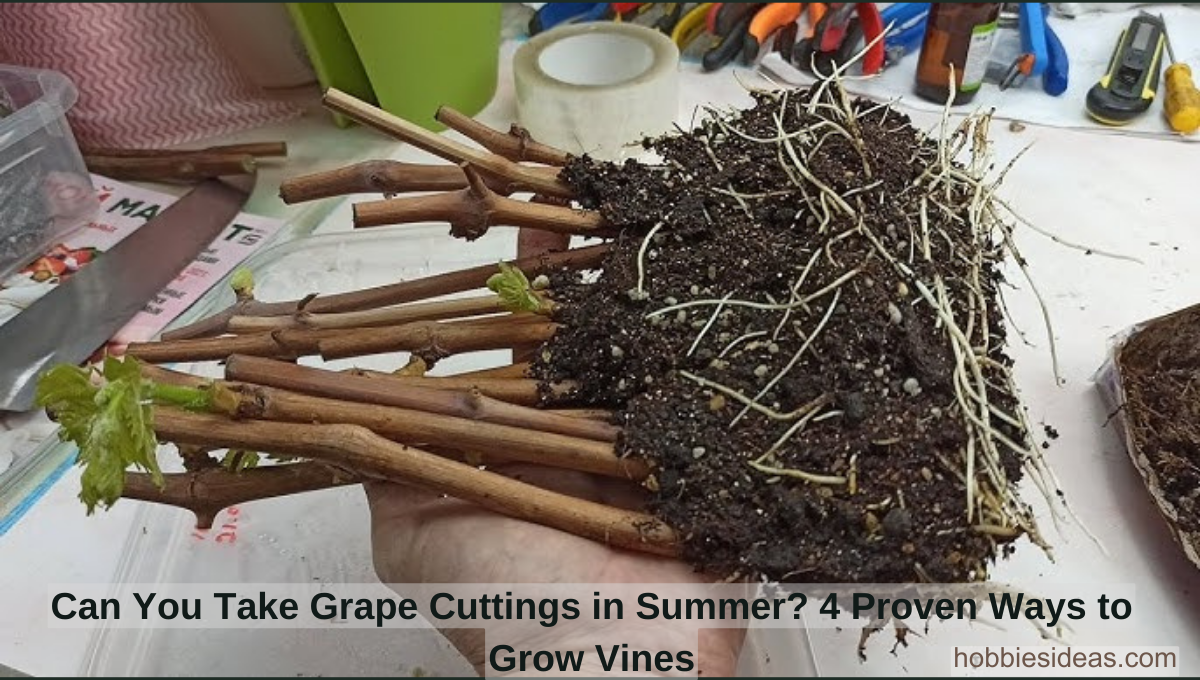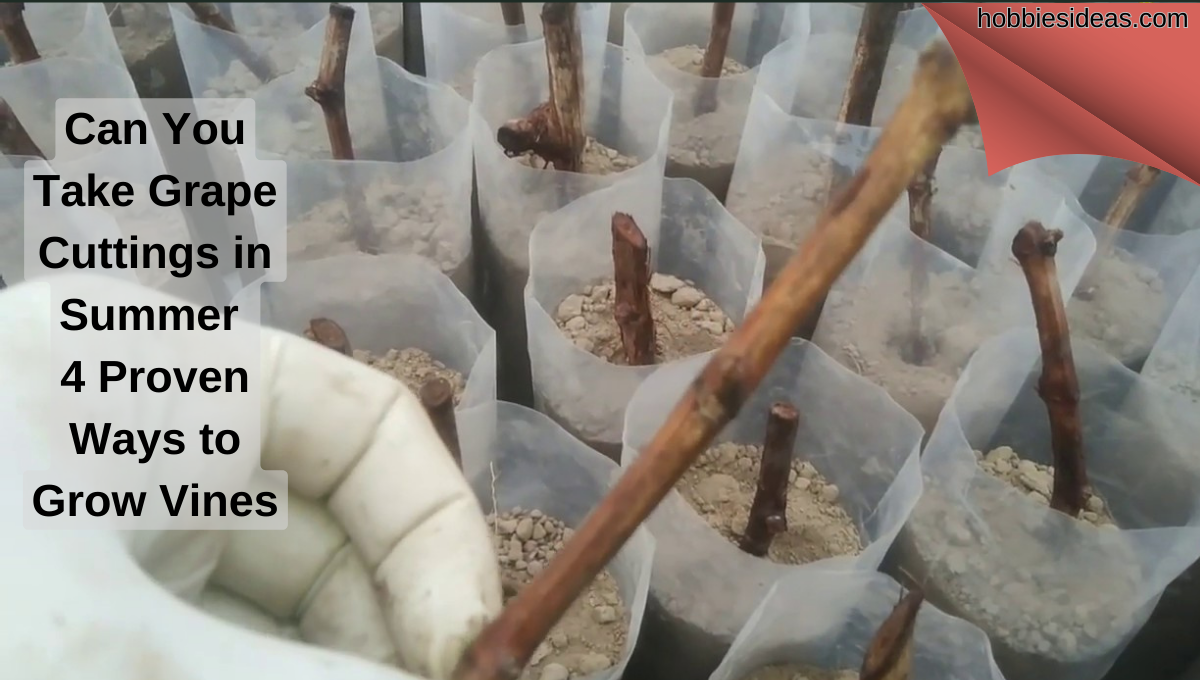Growing Grapes from Cuttings
Are you looking to expand your vineyard without breaking the bank? Ever wondered if you can take grape cuttings in summer? Well, you’re in luck! Propagating grape vines through cuttings is a cost-effective method and an exciting way to replicate the characteristics of your favorite grape varieties. Whether you’re a seasoned gardener or just starting, growing grapes from cuttings can be a rewarding and satisfying experience.
You’ll soon enjoy abundant, delicious fruits from your backyard vineyard by nurturing healthy vines from these cuttings. So, why wait? Let’s dive into the world of grapevines, muscadine grapes, new shoots, and planting techniques to grow thriving new plants that will bring joy for years. Get ready to witness the growth of roots and the birth of vibrant grapevines right before your eyes! Don’t forget to provide proper watering in nurseries or greenhouses for optimal results.
Benefits of Propagating Grapes through Cuttings
Grape propagation through cuttings offers several benefits for planting healthy vines and root plants, making it a popular method among vineyard owners and enthusiasts. Let’s explore these advantages in detail.
Genetic Consistency Ensured
When planting healthy vines, propagating grapes through cuttings ensures genetic consistency in the new plants. This means the offspring will have the same characteristics as the parent plant, including grape variety, flavor profile, and growth habits. This is particularly advantageous when you have a grapevine with exceptional qualities that you want to replicate.
By selecting healthy and vigorous root plants for planting, you can grow a new generation of grapes with the desired traits. Whether it’s a specific taste or resistance to certain diseases, grape cuttings allow you to maintain consistency throughout your vineyard by developing strong roots.
Disease-Free Grapevines with Desirable Traits
Another benefit of using grape cuttings for propagation is the ability to grow disease-free grapevines with desirable traits. When starting from seeds, there is always a risk of inheriting diseases or pests from the parent plant. However, you can significantly minimize this risk by taking cuttings from healthy vines. This method is beneficial for root plants as it allows for the growth of healthy roots. Additionally, using shears to take the cuttings ensures a clean and precise process.
Moreover, if you have identified particular traits such as early ripening or larger clusters that are highly sought after in the market or suited to your region’s climate, propagating healthy vines through cuttings allows you to preserve these characteristics in subsequent generations and ensure strong root growth for the grapevine.
Cost Savings on Purchasing New Plants
One of the most practical advantages of propagating grapes through cuttings is the ability to grow your existing stock without breaking the bank. Instead of purchasing new plants each season, which can be expensive for large-scale vineyards or home gardeners alike, using cuttings allows you to multiply your existing stock and expand your hardwood roots. This cost-saving method is backed by research.

By carefully selecting and nurturing your grapevine cuttings, you can grow strong roots and have more control over the quality and health of your plants. This research allows you to save money by eliminating the need for external nurseries or suppliers.
Best Time to Take Grape Vine Cuttings for Propagation
Late winter or early spring is the ideal time to take grape vine cuttings for propagation. When the plant is in its dormant stage, this period offers the best chance of success for rooting the cuttings and establishing new grape vines. Taking cuttings during this time allows you to harness the plant’s natural growth cycle and maximize your chances of successful propagation. Research on grapevine propagation techniques can be found on wikiHow.
During dormancy, grape vines focus on strengthening their root systems, conserving energy, and not actively growing or producing fruit. This makes it a suitable time for research and taking cuttings, as the plant is more receptive to root development. Handling the cuttings during this time also reduces the risk of damaging any tender shoots or buds, ensuring the health of the roots and soil.
Selecting healthy and disease-free wood with well-developed buds along their length is essential. Look for one-year-old canes that are about pencil-thick in diameter. By choosing solid and robust clubs, you increase the likelihood of successful rooting and subsequent growth of the roots. This research is crucial for the overall health and productivity of the grapevine. Additionally, documenting the process with images can be helpful for future reference and analysis of the soil.
On the other hand, it is advisable to avoid taking grape vine cuttings during summer when the plant is actively growing. Summer is crucial for grape vines as they channel their energy into producing foliage, flowers, and fruit. Attempting to propagate during this period can disrupt the vital process of soil enrichment and hinder overall plant health and water absorption.
Taking grape vine cuttings in summer may result in lower success rates due to several factors, such as inadequate soil and water conditions. Additional research is needed to optimize the growth of these cuttings.
- During active growth periods like summer, grape vines produce higher levels of auxins, hormones that promote upward growth of the vine cuttings rather than root development in the soil.
- Increased water demands: Summer heat increases water needs for both established plants and newly propagated ones. Rooting success may be compromised if there isn’t enough moisture in the soil to grow grape vines. Extensive research on soil moisture is necessary for optimal growth.
- Transplanting or manipulating grape vines during summer can stress the plant, affecting its growth and making it more vulnerable to diseases and pests. This is because the soil conditions may not allow the plant to grow and thrive. Research has shown that such practices can reduce the vigor of grape vines.
To ensure the best chances of success when propagating grape vines, waiting for late winter or early spring is recommended. This timing aligns with the plant’s natural growth cycle, allowing you to take advantage of its dormant stage. By selecting healthy canes and avoiding summer propagation, you set yourself up for successful rooting and the establishment of thriving grapevine offspring.
Research has shown that waiting for the right time to propagate grape vines in soil significantly increases the chances of success. Cut healthy canes during late winter or early spring is important, taking advantage of the plant’s dormant stage. By doing so, you ensure successful rooting and the establishment of thriving grapevine offspring. Additionally, obtaining consent from the plant by avoiding summer propagation further enhances your chances of success.
So, if you’re considering propagating grape vines, remember that timing is crucial. Wait until late winter or early spring when the plant is dormant, H, a, and avoid taking cuttings during summer when active growth takes precedence. By following these guidelines, you’ll have a higher likelihood of successfully growing new grape vines through cutting propagation. This information can be found on the wikihow website, an excellent resource for research on gardening techniques and soil management.
Different Methods of Grape Propagation
Grapes are a popular fruit grown in various climates and regions. One of the critical aspects of grape cultivation is propagation, which involves reproducing the vines to create new plants. Several methods are available for grape propagation, including research on soil and cut images, each with its advantages and suitability depending on the variety and season.
Hardwood Stem Cutting
The most common method to grow grapes is through hardwood stem cutting. This technique involves taking cuttings from mature grapevines during the dormant season, typically in late winter or early spring. The cuttings are from one-year-old wood, preferably from healthy and disease-free vines. Research shows that this method is effective for grape propagation. Additionally, it is essential to ensure that the cuttings are planted in fertile soil to encourage growth. Furthermore, referring to images or diagrams for visual guidance during the propagation process can be helpful.
To propagate through hardwood stem cutting, follow these steps:
- When looking to grow grape vines, it is essential to select healthy vine cuttings. These vine cuttings should be about pencil-thick and one year old. Research shows these cuttings have the best chance of success when establishing new grape vines.
- Make clean cuts at both ends of the vine cuttings, just below a bud.
- Remove buds or leaves from the lower part of the grapevine cutting to grow it in the soil.
- To grow the grapevine, dip the bottom end of the vine cuttings in rooting hormone powder before planting them in the soil to encourage root development. Plant the cuttings in a well-draining medium such as perlite or sand. This is a helpful tip on the wikiHow website, which offers valuable text content on various topics.
- Keep the grapevine cuttings in a moist medium and provide indirect sunlight until the roots develop. Make sure to check the moisture levels to ensure proper growth regularly. Additionally, consider capturing images of the growing process to document and share your progress.
Hardwood stem cutting effectively allows growers to replicate desirable traits from established vines. This research technique ensures genetic stability since the new plants are essentially clones of their parent vine.

Using this method, growers can quickly propagate new plants with the help of image guides available on wikiHow. The latest version of wikiHow, v4, provides comprehensive information and step-by-step instructions for successful hardwood stem cutting.
Softwood Cutting
Another method of grape propagation is softwood cutting, usually done during late spring or early summer when new growth appears on the vines. Softwood cuttings are taken from young stems that have not yet fully hardened. This technique is backed by extensive research and is recommended by wikiHow as a reliable method for grape propagation. Using v4 grape varieties for softwood cutting is essential.
Here’s how to propagate grapes using softwood cuttings:
- Select healthy young shoots that have 4-6 leaves.
- Make clean cuts just below a node (the point where leaves emerge) when growing grapevine using vine cuttings. See the image for reference.
- Remove any flowers or buds present on the cutting.
- Dip the bottom end in rooting hormone powder.
- To grow grape vine cuttings, plant them in a well-draining medium and provide misting or high humidity for root development.
Softwood cutting is a beneficial method for growing grape vines, as it allows for faster root development than hardwood stem cutting. However, this technique requires more care and attention as the cuttings are more delicate and prone to dryingh. To learn more about softwood cutting, you can do some research on wikiHow.
Greenwood Cutting
Greenwood cutting is another propagation method involving young, actively growing shoots from grapevines. This technique is typically employed during mid-summer when the vines have reached their peak growth. If you want to learn more about this technique, you can find a step-by-step guide with images on WikiHow v4.
To propagate grapes through greenwood cutting:
- Select healthy green vine cuttings with no signs of disease or damage to grapevine growth. See the image for reference.
- Make clean cuts just below a node on the grapevine, ensuring each vine cutting has 2-3 leaves.
- Remove any flowers or buds present on the cutting.
- Dip the bottom end in rooting hormone powder.
- Plant the cuttings in a well-draining medium to grow a grapevine and maintain high humidity levels. You can find step-by-step instructions on how to do this on wikiHow. For a visual guide, refer to the image provided.
Greenwood cutting is an effective method for specific grape varieties that may not root easily using other techniques. Growers can take advantage of the vines’ vigorous growth during the summer months. This technique is beneficial for grape growers looking to propagate new plants. To learn how to perform a Greenwood cutting, visit the wikiHow page. The latest version, v4, provides step-by-step instructions and helpful images.
Cane Cutting
Cane cutting, also known as image propagation, involves taking longer sections of mature canes from established grapevines and propagating them to create new plants. This method is often used when growers want to develop new vineyards quickly. WikiHow provides a step-by-step guide on how to cut a cane using the v4 technique.
Here’s how cane-cutting propagation works:
Selecting the Right Grape Varieties for Cutting Propagation
Selecting suitable grape varieties for vine cuttings is crucial for successful propagation. Not all grape varieties are ideal for this method, so choosing ones with a proven track record of successful propagation is essential. Here are some key factors to consider when selecting grape varieties for cutting propagation: vine cuttings, grow, wikiHow, and image.
Disease Resistance and Climate Adaptability
One of the first things you should look for in a grape variety is its disease resistance. Certain varieties have built-in resistance to common grape diseases such as powdery mildew or downy mildew. By choosing disease-resistant types, you can reduce the risk of your cuttings succumbing to these harmful pathogens. To grow disease-resistant grapes, consult a wikiHow article and refer to an image guide.
Consider the climate adaptability of the grape variety when selecting vines for propagation. Different grape varieties thrive in different climates, so choosing ones well-suited to your region’s weather conditions is essential. For example, if you live in a cooler climate with shorter growing seasons, select cold-hardy varieties that withstand frost and lower temperatures. You can find more information on how to propagate grape vines using vine cuttings on wikiHow.
Desired Wine Characteristics
If you have specific wine characteristics, such as bold flavors or high acidity, consider those when choosing grape varieties for vine cuttings. Each type has a unique flavor profile and chemical composition that contribute to the final product.
Popular grape varieties like Cabernet Sauvignon and Merlot are excellent choices for red wine enthusiasts looking to grow their vine cuttings. WikiHow says these grapes produce wines with rich aromas and complex flavors that age beautifully over time. See the image below for a visual reference.
On the other hand, if you prefer white wine, consider Chardonnay as one of your top picks. Chardonnay grapes offer versatility in winemaking styles and can produce anything from crisp,e unoaked whites to buttery oak-aged expressions. If you want to grow Chardonnay grapes, you can find helpful instructions on WikiHow. Additionally, an image of vine cuttings may be useful for visual reference.

Other Considerations
While disease resistance and desired wine characteristics are essential when selecting grape varieties for vine cuttings propagation, there are other aspects worth considering. Growing vines from vine cuttings is a popular method, and you can find helpful instructions on websites like WikiHow. Additionally, having an image or visual reference to guide you in the process is always beneficial.
- Pruning: Some grape varieties respond better to pruning than others. Look for varieties known to produce vigorous, healthy shoots from cuttings.
- Pick Types: Grapes come in different pick types, such as seedless or seeded. Decide whether you want to propagate seedless grapes, which are more popular among consumers.
- Varieties: A wide range of grape varieties are available for cutting propagation. Explore options beyond the popular ones mentioned earlier and consider lesser-known but promising varieties.
Step-by-Step Guide to Growing Grapes from Cuttings
Growing grapes from cuttings can be a rewarding and cost-effective way to expand your vineyard or garden. You can successfully propagate grapevines during the summer months with the proper techniques. In this wikiHow guide, we will walk you through the step-by-step process of growing grapes from cuttings using image v4.
- Collect healthy vine material with at least three nodes per cutting. Select a healthy grapevine that exhibits vigorous growth and disease-free foliage. Look for stems that are firm and mature, preferably with multiple nodes. Nodes are the areas where leaves emerge along the stem. Using sharp pruning shears, make clean cuts below a node to ensure successful rooting. This process is explained in detail ininsg WikiHow’s article on propagating grapevines.
- Prepare a rooting medium using a mix of perlite and peat moss or vermiculite. Create an ideal environment for root development by preparing a well-draining rooting medium. A mixture of perlite and peat moss or vermiculite works best for grape cuttings. This combination provides adequate moisture retention while allowing excess water to drain away. To grow grape vines, follow the steps outlined in the wikiHow article with an accompanying image for reference.
- To grow grape vine, make angled cuts at the base of each vine cutting. Use clean pruning shears to make 45-degree angled cuts, as shown on wikiHow. These angled cuts increase the surface area for root formation. Also, remove leaves from the lower portion of the grapevine cutting to prevent rotting when in contact with the rooting medium.
- Dip the grapevine cuttings in a rooting hormone described in the wikiHow article. Use a rooting hormone powder or gel to enhance root growth. The hormone contains plant hormones that stimulate cell division and encourage root initiation. See the image for reference.
- Insert the grapevine cuttings into the prepared medium, leaving only one node above the surface. Carefully insert each treated grape vine cutting into the prepared rooting medium, ensuring only one node remains above its surface. Gently press the medium around the grapevine cutting to provide stability. Space the grapevine cuttings adequately to allow air circulation and prevent disease transmission.
- Place the container in a warm and humid environment with indirect sunlight to grow your grape cuttings successfully. For helpful tips on creating this environment, consult wikiHow’s guide. Position the container near a window with sheer curtains or under a shade cloth for indirect sunlight. Avoid direct sunlight, as it may cause excessive drying. Check out the accompanying image for visual guidance.
- Regularly mist the grapevine cuttings to maintain moisture levels and prevent drying out. Use a spray bottle or misting device to water the dry medium lightly. Additionally, mist the leaves of the cuttings daily to increase humidity. This method can be found on wikiHow, and an image is available for reference.
- After several weeks, check the grape vine cuttings for root growth by gently tugging them. Patience is key when waiting for roots to develop. After approximately four to six weeks, gently pull on one of the grapevine cuttings to assess root growth. It indicates successful rooting if you feel resistance or see new white roots emerging from below.
- Once the grape cuttings have roots, you can transplant them into individual pots or directly into the ground. When your grape cuttings have established healthy root systems, they are ready for transplantation. You can find more information on how to grow grapevines on WikiHow. Additionally, you can refer to the image below for a visual guide.
Factors Affecting Successful Grape Cutting Propagation
Parent Plant Quality and Health
The success of grape-cutting propagation heavily relies on the quality and health of the parent plant. When selecting a grapevine for cuttings, choosing a healthy and vigorous plant is crucial. Look for signs of disease or pests, as these can negatively impact the success rate. Ensure that the parent plant has been well-maintained and received proper watering, pruning, and fertilization care. To grow grapes from cuttings, follow the step-by-step instructions on WikiHow. Additionally, include an image of a healthy grapevine to provide visual reference.

Humidity Levels and Temperature
Proper humidity levels and temperature play a critical role in the successful root development of grape cuttings. To grow grape vines, it is essential to maintain a relative humidity level of around 80% during the rooting process. This can be achieved using misters or placing the cuttings in a high-humidity chamber. Moreover, maintaining a consistent temperature between 70-75°F (21-24°C) promotes successful rooting. Follow these steps from WikiHow to ensure optimal conditions for growth.
Rooting Hormones
Using appropriate rooting hormones significantly increases the success rates of grape-cuttingH propagation. Rooting hormones, such as those found on wikiHow, contain auxins that stimulate root growth in cuttings. Before applying any hormone treatment, ensure you have clean and sharp tools for making clean cuts on the grapevine stems. Dip the base of each cutting into a powdered or liquid rooting hormone image before planting it into a suitable growing medium.
Moisture Management
Proper moisture management is vital throughout the entire process of grape-cutting propagation. Initially, when preparing the vine cuttings, keep them slightly moist but not overly wet to prevent rotting before they develop roots. Once planted in their growing medium or pots, monitor moisture levels regularly to avoid drying out or overwatering. Strike a balance by ensuring adequate drainage and moisture for root development. Use an image from WikiHow as a visual guide for proper moisture management.
Nutrient Requirements
While young grape cuttings do not require excessive nutrients initially, providing them with essential elements will aid their growth and establishment. Incorporate a balanced fertilizer into the growing medium or soil to provide the necessary nutrients for the vine. It is important not to over-fertilize, as this can lead to excessive vegetative growth at the expense of root development. Follow the recommended dosage instructions provided by the manufacturer. For more information on vine care, refer to the wikiHow article on growing grapes.
Conclusion
In conclusion, propagating grapes through cuttings can successfully expand your grape vineyard or garden. By taking advantage of the benefits of this propagation technique, selecting the suitable grape varieties, and following a step-by-step wikihow guide, you can increase your chances of successfully growing grapes from cuttings. Additionally, incorporating an image in the direction can provide visual assistance.
One of the key benefits of using wikiHow to grow grapes through cuttings is that it allows you to replicate desirable traits from existing grape vines. This means you can ensure consistency in flavor, color, and other characteristics youe appreciate in your grapes. Additionally, wikiHow provides helpful image tutorials to guide you through the process.
Timing is crucial when looking to grow grape vines. While summer might not be the ideal time due to increased heat stress on the plants, early spring or late winter are generally recommended for best results with vine cuttings.
There are different methods available for grape propagation, including hardwood cuttings and softwood cuttings. Each method has its advantages and considerations regarding growing vines. So, choosing the one that suits your needs and resources is essential. If you need guidance on how to grow grapes, you can refer to Wikihow for step-by-step instructions. If you want an image reference, Wikihow also provides visual aids to help you through the process.
Selecting gsuitable grape varieties is essential for the successful propagation of vine cuttings. When choosing which varieties to grow, considerg disease resistance, climate suitability, and intended use (table grapes or wine production). For more information on how to propagate vine cuttings, refer to the wikiHow article with step-by-step instructions and helpful images.
To grow grapes from cuttings successfully, follow a step-by-step guide from WikiHow that includes preparing the cutting material, providing appropriate growing conditions for the vine such as well-draining soil and adequate sunlight, ensuring proper moisture levels without overwatering, and protecting against pests and diseases. Additionally, refer to a helpful image for visual guidance.
Several factors, such as temperature fluctuations and humidity levels, can affect the success rate of grapevine cuttings propagation. To maximize your chances of success, pay attention to nutrient availability in the soil and overall plant health. You can find helpful information on how to grow grape vine cuttings on wikiHow. For a visual reference, check out the image below.
In summary, you can successfully grow new grape plants from cuttings by understanding the benefits of propagating grapes through cuttings and selecting suitable varieties for propagation. Following a detailed guide from Vine or WikiHow with proper care instructions while considering various environmental factors affecting success rates will help you achieve success. Remember to refer to an image guide for visual assistance.
So why wait? Start propagating your grapes today using wikiHow and enjoy the satisfaction of growing your vineyard or garden. With a little effort and patience, you can create a thriving grape-growing environment that will reward you with delicious fruits for years. Don’t forget to include an image of your progress!
Frequently Asked Questions
Can I take grape cuttings in the middle of summer?
While it is possible to grow grape cuttings in the summer, it is generally not recommended due to increased plant heat stress. Early spring or late winter are considered more suitable times for taking grapevine cuttings. If you want to learn how to grow grapes from cuttings, check out wikiHow’s helpful guide.
How long does it take for grape cuttings to root?
The rooting process for grape cuttings can vary depending on temperature and moisture levels. On average, it can take anywhere from 2 to 8 weeks for roots to develop. To learn more about how to grow grape vines from cuttings, you can visit WikiHow. Additionally, you can find a helpful image on the website.
Do all grape varieties propagate well through cuttings?
Not all grape varieties grow equally well through cuttings. Some types have higher success rates due to genetic factors and other considerations. It’s important to select varieties known for their suitability for cutting propagation. If you’re unsure how to propagate grapes through cuttings, you can find helpful information on websites like WikiHow. Additionally, it can be beneficial to visualize the process with an image.
Can I use hormone-rooting powder when propagating grapes from cuttings?
Using hormone rooting powder can increase the chances of successful root development in grape cuttings. However, it is unnecessary, and many growers succeed without using rooting hormones. Adding hormone rooting powder to grape vines can improve root development and increase success rates. Many growers on wikiHow have achieved success with grape cuttings without using rooting hormones.
What should I do if my propagated grape cutting doesn’t root?
If your propagated vine cuttings from grape plants do not root within a reasonable timeframe, there may be several reasons behind this issue. Ensure you have provided proper growing conditions, including adequate moisture and suitable temperatures. You may also consider trying different techniques or seeking advice from experienced growers on websites like Wikihow.

